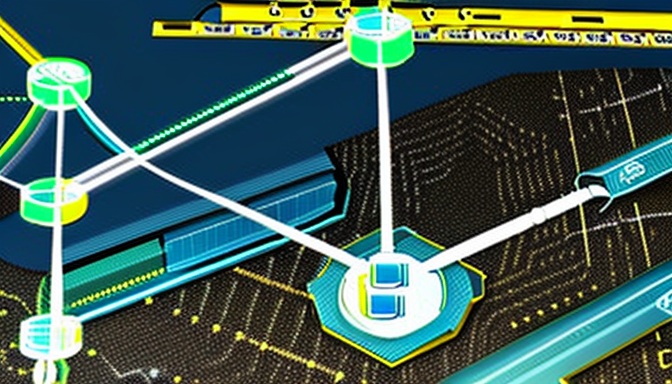Consensus mechanisms are critical to the operation and security of cryptocurrency networks. They are the protocols that enable all participants to agree on the validity of transactions, thereby preserving the integrity and transparency of decentralized systems. Without these mechanisms, the risk of fraud and manipulation increases significantly, undermining the trust that users place in digital currencies.
Understanding Consensus Mechanisms
At their core, consensus mechanisms serve as the backbone of blockchain technology, facilitating agreement among distributed nodes without relying on a central authority. This decentralized agreement is essential for maintaining a secure and reliable network, where every transaction is validated and recorded in a tamper-proof manner. The mechanisms can be classified into several types, each with its unique approach to achieving consensus.
Types of Consensus Mechanisms
- Proof of Work (PoW): This was the first consensus mechanism implemented by Bitcoin. In PoW, miners compete to solve complex mathematical puzzles, and the first to solve it gets to add a new block to the blockchain. This process, while secure, is energy-intensive.
- Proof of Stake (PoS): PoS mitigates some of the energy concerns associated with PoW by allowing validators to create new blocks based on the number of coins they hold and are willing to stake. This approach incentivizes participants to act honestly, as they risk losing their staked assets.
- Delegated Proof of Stake (DPoS): DPoS enhances efficiency by allowing token holders to elect a small number of delegates responsible for validating transactions. This method can lead to faster transaction times and increased scalability.
Benefits of Proof of Stake
PoS offers various advantages, including reduced energy consumption and enhanced transaction speeds. Research indicates that PoS networks can process transactions significantly faster than PoW networks, making them attractive for users seeking efficiency.
Challenges of PoS
Despite its benefits, PoS is not without challenges. One notable issue is the “rich get richer” problem, where wealthier participants may gain more influence over the network. Ongoing research is focused on developing solutions to promote fairness and mitigate this issue.
The Future of Consensus Mechanisms
As the cryptocurrency landscape continues to evolve, new consensus mechanisms are emerging to address existing limitations. Innovations are aimed at enhancing security, scalability, and sustainability within decentralized networks. Hybrid models that combine elements of PoW and PoS are being explored to balance security and energy efficiency.
Conclusion: The Role of Consensus in the Crypto Ecosystem
In summary, consensus mechanisms are vital for the security and functionality of cryptocurrency networks. Understanding their nuances enables stakeholders to make informed decisions, paving the way for a more robust and sustainable crypto ecosystem. As the technology advances, the development of more efficient consensus protocols will be crucial in addressing the challenges faced by current systems.

Understanding Consensus Mechanisms
is essential for grasping how decentralized networks maintain integrity and security. These mechanisms act as the backbone of blockchain technology, ensuring that all participants in a network agree on the validity of transactions without the need for a central authority. This decentralized agreement is crucial for preventing fraud and ensuring that all records are accurate and trustworthy.
At its core, a consensus mechanism is a protocol that determines how transactions are verified and added to a blockchain. The most widely recognized consensus mechanisms include Proof of Work (PoW), Proof of Stake (PoS), and Delegated Proof of Stake (DPoS). Each of these mechanisms employs unique methods to achieve consensus, impacting the overall performance, security, and scalability of the network.
Proof of Work (PoW) is the original consensus mechanism, famously utilized by Bitcoin. In PoW, miners compete to solve complex mathematical problems, and the first one to solve it gets the right to add a new block to the blockchain. While this method ensures security, it is also notorious for its high energy consumption, raising environmental concerns. A study published in the journal Nature Communications highlighted that Bitcoin mining consumes more energy annually than some entire countries, prompting a search for more sustainable alternatives.
In contrast, Proof of Stake (PoS) offers a more energy-efficient alternative by allowing validators to create new blocks based on the number of coins they hold and are willing to stake as collateral. This method significantly reduces energy usage and increases transaction speeds. Research from the Journal of Blockchain Research indicates that PoS networks can process transactions more efficiently than their PoW counterparts, making them a viable option for future blockchain applications.
However, PoS is not without its challenges. One notable issue is the “rich get richer” problem, where individuals with substantial holdings have disproportionate influence over the network. Ongoing research aims to develop solutions that enhance fairness and equity in PoS systems.
Delegated Proof of Stake (DPoS) introduces a governance layer, allowing token holders to elect a small number of delegates responsible for validating transactions. This system can enhance efficiency and scalability, as evidenced by the EOS blockchain, which is known for its high transaction throughput and effective governance model.
As the cryptocurrency landscape evolves, the future of consensus mechanisms is likely to see innovations aimed at improving security, scalability, and sustainability. Hybrid models that combine elements of PoW and PoS are emerging, striving to balance the strengths of both systems.
In conclusion, understanding consensus mechanisms is vital for anyone involved in the cryptocurrency ecosystem. By grasping how these protocols function, stakeholders can make informed decisions that contribute to a more secure and efficient decentralized network.

Types of Consensus Mechanisms
are essential for ensuring the security and efficiency of blockchain networks. These mechanisms are the backbone of decentralized systems, enabling participants to agree on the state of the ledger without a central authority. The most prevalent consensus mechanisms include Proof of Work (PoW), Proof of Stake (PoS), and Delegated Proof of Stake (DPoS). Each has its unique characteristics and implications for network performance and energy consumption.
Proof of Work (PoW) is the original consensus mechanism, famously utilized by Bitcoin. In this system, miners compete to solve complex mathematical puzzles, and the first to succeed earns the right to add a new block to the blockchain. This process, while secure, is energy-intensive. Research indicates that Bitcoin mining consumes more electricity annually than some countries, raising serious environmental concerns. A study by the University of Cambridge highlighted that Bitcoin’s energy consumption is comparable to that of the Netherlands, prompting calls for more sustainable practices in cryptocurrency mining.
Proof of Stake (PoS) emerged as a response to the energy inefficiency of PoW. In PoS, validators are chosen to create new blocks based on the number of coins they hold and are willing to “stake.” This approach significantly reduces energy consumption, as it eliminates the need for power-hungry mining equipment. A 2020 study published in the journal Nature Communications found that PoS networks could process transactions up to 100 times faster than PoW systems. However, PoS is not without its challenges. The “rich get richer” problem can lead to centralization, where wealthier participants exert more influence over the network.
Delegated Proof of Stake (DPoS) takes PoS a step further by introducing a voting mechanism. Token holders elect a small number of delegates who are responsible for validating transactions. This method enhances efficiency and scalability, allowing networks to process thousands of transactions per second. A notable example is the EOS blockchain, which has demonstrated the potential of DPoS by supporting decentralized applications (dApps) with high transaction throughput.
As the cryptocurrency landscape continues to evolve, new consensus mechanisms are being developed to address the limitations of existing models. Hybrid models that combine PoW and PoS elements are gaining traction, aiming to balance security and energy efficiency. Furthermore, regulatory considerations will shape the future of these mechanisms, as governments seek to establish frameworks that ensure compliance and promote sustainable practices.
In conclusion, understanding the various types of consensus mechanisms is crucial for stakeholders in the cryptocurrency ecosystem. Each mechanism offers distinct advantages and challenges, influencing the overall performance and sustainability of blockchain networks. By staying informed about these developments, participants can make better decisions that align with their values and objectives.
Proof of Work (PoW)
serves as the foundational consensus mechanism for Bitcoin, introduced by its creator, Satoshi Nakamoto, in 2009. This mechanism is pivotal in ensuring the security and integrity of the blockchain, a decentralized ledger that records all transactions. In PoW, miners compete to solve intricate mathematical puzzles that require significant computational power. The first miner to successfully solve the puzzle is granted the right to add a new block to the blockchain, a process that is rewarded with newly minted bitcoins and transaction fees.
The mathematical problems miners tackle are designed to be resource-intensive, which deters malicious activities such as double-spending. This characteristic of PoW ensures that altering any aspect of the blockchain would require an immense amount of computational power, making it economically unfeasible for attackers. According to a study published in the Journal of Cryptographic Engineering, the security provided by PoW is directly proportional to the total computational power of the network, often referred to as the network’s hash rate.
However, the energy consumption associated with PoW has raised significant concerns. Research from the Cambridge Centre for Alternative Finance indicates that Bitcoin mining consumes more electricity annually than some small countries. This has sparked a debate about the environmental implications of cryptocurrencies, leading to calls for more sustainable practices within the industry. In response, some projects are exploring alternative consensus mechanisms that consume less energy, such as Proof of Stake (PoS).
Despite its energy demands, PoW is lauded for its decentralization and security. The substantial investment in hardware and electricity required to mine Bitcoin creates a barrier to entry, which can prevent centralization of power among a few entities. This decentralization is crucial for maintaining the ethos of cryptocurrencies, which aims to eliminate reliance on centralized authorities.
Furthermore, the PoW mechanism has been critically evaluated through various case studies. For instance, the Ethereum network, initially using PoW, has transitioned to PoS to enhance scalability and reduce energy consumption. This shift highlights the ongoing evolution within the cryptocurrency landscape, where efficiency and sustainability are becoming increasingly paramount.
In conclusion, while Proof of Work has played a significant role in the establishment of Bitcoin and the cryptocurrency ecosystem, its drawbacks have prompted discussions about the future of consensus mechanisms. As the industry continues to innovate, understanding the implications of PoW and its alternatives will be essential for stakeholders navigating this complex environment.
Energy Consumption Concerns
The energy consumption associated with Proof of Work (PoW) consensus mechanisms has become a significant point of discussion in the realm of cryptocurrency. As the primary mechanism for Bitcoin and several other cryptocurrencies, PoW requires miners to solve complex mathematical problems to validate transactions and add them to the blockchain. This process is not only computationally intensive but also demands an enormous amount of electricity, raising alarms about its environmental impact.
Research indicates that the energy consumption of Bitcoin mining alone surpasses that of entire countries. For instance, a report from the Cambridge Centre for Alternative Finance estimates that Bitcoin’s energy usage is comparable to that of the Netherlands. This staggering figure emphasizes the urgent need for more sustainable alternatives within the cryptocurrency space.
One of the primary criticisms of PoW is its reliance on fossil fuels for energy. In many regions, mining operations are powered by coal, which significantly contributes to carbon emissions. A study published in the journal Nature Communications highlighted that if Bitcoin were a country, it would rank in the top 30 for electricity consumption, further underscoring the environmental concerns associated with its mining practices.
In response to these challenges, the cryptocurrency community is exploring various alternatives. Proof of Stake (PoS) has emerged as a popular choice, offering a less energy-intensive method for validating transactions. Unlike PoW, PoS relies on validators who are chosen to create new blocks based on the number of coins they hold and are willing to stake. This mechanism drastically reduces the energy required for transaction validation, making it a more environmentally friendly option.
Moreover, hybrid models that combine elements of both PoW and PoS are being developed. These models aim to leverage the security features of PoW while mitigating its energy consumption. For example, projects like Ethereum are transitioning from PoW to PoS, reflecting a broader industry shift towards energy-efficient consensus mechanisms.
In conclusion, while PoW has played a crucial role in the evolution of cryptocurrencies, its energy-intensive nature poses significant environmental challenges. The shift towards more sustainable alternatives, such as PoS and hybrid models, is essential for the long-term viability of cryptocurrency networks. As the industry continues to evolve, it is imperative that stakeholders prioritize sustainability to ensure a balanced approach to innovation and environmental stewardship.
Security and Decentralization
are two of the most crucial aspects of cryptocurrency networks, particularly in the context of the Proof of Work (PoW) consensus mechanism. PoW, which was originally implemented by Bitcoin, requires miners to solve complex mathematical puzzles to validate transactions and create new blocks. This process not only secures the network but also ensures that it remains decentralized, as no single entity can easily dominate the mining process.
The computational power needed for PoW is substantial, which acts as a formidable barrier against potential attacks. For instance, to successfully execute a 51% attack—where a single entity gains control of the majority of the network’s mining power—an attacker would need to amass an enormous amount of computational resources. This requirement makes it economically unfeasible for most malicious actors, thereby enhancing the network’s security. Research published in the Journal of Economic Behavior & Organization demonstrates that the high cost of mining equipment and electricity serves as a deterrent to such attacks.
Furthermore, the decentralized nature of PoW means that no central authority controls the network. This decentralization is achieved through a distributed network of nodes that validate transactions independently. A study by the Nature Communications journal highlights how this structure mitigates the risks associated with centralization, such as data manipulation and censorship. Each participant in the network can independently verify transactions, contributing to a collective trust in the system.
One of the most significant advantages of PoW is its resilience against Sybil attacks, where an attacker creates multiple fake identities to gain influence over the network. The requirement for substantial computational effort means that creating numerous identities would not only be costly but also impractical. A report from the arXiv preprint server indicates that PoW networks maintain a high level of integrity due to these inherent challenges faced by potential attackers.
However, it is essential to acknowledge the criticisms surrounding PoW, particularly its environmental impact due to high energy consumption. As the cryptocurrency landscape evolves, discussions around improving energy efficiency while retaining security and decentralization are becoming more prominent. Ongoing research is exploring alternative consensus mechanisms that aim to achieve similar security levels with reduced energy footprints.
In conclusion, while PoW has its drawbacks, its strengths in security and decentralization make it a critical component of the cryptocurrency ecosystem. Understanding these dynamics is vital for stakeholders as they navigate the complexities of blockchain technology.
Proof of Stake (PoS)
is a revolutionary consensus mechanism that addresses several drawbacks associated with its predecessor, Proof of Work (PoW). In PoW, miners expend vast amounts of energy to solve complex mathematical problems, which can lead to significant environmental concerns. In contrast, PoS allows validators to create new blocks based on the amount of cryptocurrency they hold and are willing to stake as collateral. This shift not only reduces energy consumption but also promotes a more equitable distribution of power within the network.
One of the primary benefits of PoS is its ability to enhance transaction speed and efficiency. Research indicates that PoS networks can process transactions significantly faster than PoW networks. For example, the Ethereum network is transitioning from PoW to PoS to improve scalability and reduce congestion, which has plagued its users during peak times.
In PoS systems, validators are incentivized to act honestly because they risk losing their staked assets. This economic model creates a secure environment for transaction validation, as those who validate blocks are selected based on the number of coins they hold and are willing to stake. As a result, it fosters a sense of accountability among validators, which is crucial for maintaining the integrity of the network.
However, PoS is not without its challenges. One notable concern is the rich get richer problem, where individuals with substantial holdings have more influence over the network. This can lead to centralization, undermining the very principles of decentralization that cryptocurrency aims to uphold. Ongoing research is exploring solutions to this issue, such as introducing mechanisms that limit the influence of large stakeholders.
To illustrate the practical implications of PoS, consider the case study of Cardano. Cardano employs a unique PoS protocol known as Ouroboros, which has been rigorously peer-reviewed and is designed to ensure both security and sustainability. The protocol allows users to participate in the network’s governance while minimizing energy consumption, demonstrating a viable alternative to traditional PoW systems.
In conclusion, Proof of Stake represents a significant advancement in the field of cryptocurrency, offering a more sustainable and efficient alternative to Proof of Work. As the cryptocurrency landscape continues to evolve, it is essential to understand the implications of these consensus mechanisms on the broader ecosystem. By fostering secure, efficient, and equitable networks, PoS can help pave the way for a more robust and sustainable future in digital finance.
stake
refers to the amount of cryptocurrency that a user locks up in a network to participate in the validation process, particularly in Proof of Stake (PoS) mechanisms. This concept is essential in the evolving landscape of blockchain technology, where energy efficiency and security are paramount. In PoS systems, the likelihood of being chosen to validate transactions is directly proportional to the amount of cryptocurrency staked. This incentivizes users to hold onto their coins, thereby reducing the circulating supply and potentially increasing the value of the currency.
Research indicates that PoS mechanisms can significantly reduce energy consumption compared to traditional Proof of Work (PoW) systems. For instance, a study by the University of Cambridge highlighted that Bitcoin mining consumes approximately 0.5% of the world’s electricity, raising environmental concerns. In contrast, PoS networks, such as Ethereum 2.0, aim to decrease this consumption by over 99%, making them more sustainable alternatives.
One notable example of a successful PoS implementation is Cardano. Cardano’s Ouroboros protocol allows users to participate in the staking process without needing expensive hardware. This democratizes access to network validation, enabling a broader range of participants. According to a report by IOHK, Cardano’s PoS model has been shown to maintain high levels of security while being energy-efficient.
- Benefits of Staking:
- Lower energy consumption compared to PoW systems.
- Increased transaction speeds and throughput.
- Enhanced security through economic incentives for honest behavior.
- Challenges of Staking:
- The “rich get richer” problem, where wealthier participants have more influence.
- Potential centralization if a small number of users control large amounts of stake.
Furthermore, the concept of Delegated Proof of Stake (DPoS) introduces a more democratic approach to staking. In DPoS, stakeholders can vote for delegates who will validate transactions on their behalf, which can lead to faster consensus and increased scalability. A case study on the EOS network illustrates this model’s effectiveness, achieving thousands of transactions per second while maintaining user engagement in governance.
As the cryptocurrency landscape continues to evolve, the importance of staking mechanisms cannot be overstated. They not only enhance network security and efficiency but also promote a more sustainable and equitable financial ecosystem. Stakeholders, including investors and developers, must stay informed about the latest developments in staking technologies to make educated decisions about their participation in these networks.
In conclusion, understanding the dynamics of staking is crucial for anyone involved in cryptocurrency. The transition from energy-intensive PoW to more sustainable PoS and DPoS models represents a significant shift in how blockchain networks operate. By leveraging staking, participants can contribute to a more secure and efficient future for the crypto ecosystem.
as collateral.
Collateral in the context of finance and cryptocurrency refers to an asset that a borrower offers to a lender as a guarantee for a loan or credit extension. This mechanism ensures that the lender can recover their funds if the borrower defaults. In cryptocurrency, collateral is particularly significant in decentralized finance (DeFi) platforms, where users can lock their assets to secure loans or participate in various financial activities.
One prevalent use of collateral in the crypto space is seen in decentralized lending platforms. For instance, platforms like Aave and Compound allow users to deposit cryptocurrencies as collateral to borrow other assets. The amount that can be borrowed is typically a fraction of the collateral’s value, ensuring that the lender’s risk is minimized. These platforms utilize smart contracts to manage collateralization ratios, automatically liquidating collateral if its value falls below a certain threshold.
Research indicates that the collateralization ratio is a critical factor in determining the stability of DeFi lending protocols. A study published in the Journal of Financial Stability highlights that maintaining a higher collateralization ratio can mitigate risks associated with price volatility in cryptocurrency markets. For example, if a user deposits $1,000 worth of Ethereum as collateral but borrows only $500, the protocol is less likely to face liquidation risks during market downturns.
Moreover, the choice of collateral can impact the interest rates on loans. Different cryptocurrencies exhibit varying levels of volatility and liquidity, influencing the risk assessment by lending protocols. For example, stablecoins, which are pegged to traditional currencies, often serve as preferred collateral due to their price stability, resulting in lower interest rates for borrowers.
Case Study: MakerDAO
- MakerDAO is a prominent example of a decentralized lending platform that uses collateralized debt positions (CDPs).
- Users can lock up assets like ETH or BAT to mint DAI, a stablecoin.
- The system ensures that the value of collateral exceeds the value of the minted DAI, thereby maintaining stability.
While collateralization offers numerous benefits, it is not without challenges. The liquidation process can lead to significant losses for users if the market experiences sudden downturns. Additionally, the rich get richer problem persists, where wealthier users can afford to lock up more collateral, giving them greater access to loans and financial opportunities.
In conclusion, collateral plays a vital role in the cryptocurrency ecosystem, particularly within DeFi platforms. Understanding its mechanisms and implications can empower users to navigate the complexities of digital finance effectively. As the landscape continues to evolve, ongoing research and innovation will be crucial in enhancing the efficiency and security of collateralized lending.
Benefits of Proof of Stake
systems have garnered significant attention in the cryptocurrency landscape, primarily due to their ability to address some of the critical limitations associated with traditional Proof of Work (PoW) mechanisms. One of the most notable advantages is reduced energy consumption. Unlike PoW, which relies on energy-intensive computational tasks performed by miners, PoS allows validators to create new blocks based on the number of coins they hold and are willing to stake. This shift not only conserves energy but also promotes a more sustainable approach to blockchain technology.
Research indicates that PoS networks can process transactions at a much higher rate than their PoW counterparts. For instance, the Ethereum network, which transitioned to PoS with its Ethereum 2.0 upgrade, has reported transaction speeds that significantly outpace those of Bitcoin. This increase in efficiency is particularly beneficial for applications requiring rapid transaction confirmation, such as decentralized finance (DeFi) platforms and non-fungible token (NFT) marketplaces.
Moreover, the economic incentives in PoS systems create a secure environment for transaction validation. Validators are required to stake their coins, meaning they have a vested interest in maintaining the network’s integrity. If they act dishonestly or attempt to validate fraudulent transactions, they risk losing their staked assets. This mechanism fosters a culture of accountability among validators, which is essential for maintaining trust in decentralized networks.
To illustrate the effectiveness of PoS, consider the case of Cardano, a blockchain platform that employs a unique PoS protocol known as Ouroboros. This protocol not only enhances security but also enables the network to achieve consensus with significantly lower energy requirements. Studies have shown that Cardano’s approach can lead to energy consumption reductions of up to 99% compared to traditional PoW systems.
However, it is essential to acknowledge the challenges that PoS faces, such as the rich get richer problem. This phenomenon occurs when individuals with larger stakes have disproportionate influence over the network, potentially leading to centralization. Ongoing research and development are focused on creating mechanisms to mitigate this issue, ensuring that PoS remains a fair and equitable system.
In conclusion, the benefits of Proof of Stake are clear: reduced energy consumption, increased transaction speeds, and enhanced security through economic incentives. As the cryptocurrency landscape continues to evolve, PoS presents a compelling alternative to PoW, paving the way for a more sustainable and efficient future for blockchain technology.
Security Mechanisms in PoS
The Importance of Security Mechanisms in Proof of Stake (PoS)In the realm of cryptocurrency, ensuring the integrity and security of transactions is paramount. One of the most innovative solutions to this challenge is the **Proof of Stake (PoS)** consensus mechanism, which operates on a fundamentally different principle than its predecessor, Proof of Work (PoW). In PoS, validators are not rewarded for solving complex mathematical problems but are instead selected to create new blocks based on the amount of cryptocurrency they hold and are willing to “stake” as collateral. This system incentivizes honest behavior among validators, as they stand to lose their staked assets if they attempt to act maliciously.
The economic model inherent in PoS creates a robust framework for maintaining security. Validators who misbehave can face penalties, including the loss of their staked funds. This risk acts as a powerful deterrent against fraudulent activities, ensuring that only those participants who are genuinely invested in the network’s health will take part in the validation process. For example, research conducted by the University of Cambridge highlights that PoS networks, such as Ethereum 2.0, have shown a significant reduction in the occurrence of double-spending attacks due to the financial disincentives for dishonest behavior.
Moreover, PoS systems enhance network security by promoting decentralization. Unlike PoW, where mining power can become concentrated among a few entities with significant computational resources, PoS allows a wider range of participants to engage in the validation process. This democratization of the staking process means that even individuals with smaller amounts of cryptocurrency can contribute to network security, thereby reducing the risk of centralization.
To illustrate the effectiveness of PoS, consider the case of Cardano, a prominent blockchain platform that utilizes this consensus mechanism. Cardano’s unique approach to staking allows users to delegate their stake to a pool, thereby participating in the network’s security without needing to run a full node. This flexibility not only broadens participation but also ensures that the network remains resilient against attacks.
In conclusion, the security mechanisms embedded within Proof of Stake systems play a crucial role in fostering a safe and reliable environment for transaction validation. By aligning the financial interests of validators with the overall health of the network, PoS effectively mitigates risks associated with malicious behavior. As the cryptocurrency landscape continues to evolve, the adoption and refinement of PoS will likely contribute to the development of more secure and efficient decentralized systems.

Challenges of PoS
Challenges of Proof of Stake (PoS) present significant hurdles that must be addressed for its broader adoption in cryptocurrency networks. While PoS offers numerous advantages, including energy efficiency and faster transaction processing, it is not without its complications. Understanding these challenges is crucial for developers, investors, and users alike.
One of the primary issues with PoS is the wealth concentration phenomenon, often referred to as the “rich get richer” problem. In PoS systems, the likelihood of being selected to validate transactions increases with the amount of cryptocurrency held. This creates a scenario where wealthier participants can accumulate more coins, thereby gaining disproportionate influence over the network. A study published in the Journal of Cryptographic Research highlights that this can lead to a lack of decentralization, as a small number of validators control a significant portion of the network’s operations.
Furthermore, PoS networks can be vulnerable to long-range attacks. In such scenarios, attackers could create an alternative chain by accumulating coins over time, which could potentially undermine the integrity of the original blockchain. Research from the International Journal of Information Security indicates that while mechanisms like checkpointing can mitigate this risk, they introduce additional complexities and potential points of failure.
Another challenge is the validator selection process. While PoS aims to democratize the validation process, in practice, it can lead to a scenario where only a few entities consistently get selected. This can discourage new participants from entering the ecosystem, leading to a stagnation of innovation and diversity within the network. A comparative analysis in the Blockchain Research and Applications journal suggests that more transparent and randomized selection methods may be necessary to enhance inclusivity.
Moreover, the security of staked assets poses a concern. Validators risk losing their staked coins if they act maliciously or fail to validate transactions correctly. While this economic incentive promotes honesty, it can also deter participation from individuals who may be hesitant to lock up their assets for extended periods. A survey conducted by the Cryptocurrency Research Institute found that potential validators often express concerns about the risks associated with staking, which could limit the growth of PoS networks.
In conclusion, while Proof of Stake offers a promising alternative to traditional consensus mechanisms, it is imperative to address these challenges to ensure a fair, secure, and decentralized environment. Ongoing research and community discussions are essential to refine PoS protocols and create robust solutions that can withstand the test of time.
rich get richer
The phrase “rich get richer” encapsulates a significant economic phenomenon observed in various sectors, including health. This concept suggests that individuals or entities with substantial resources are often able to leverage their wealth to generate more wealth, creating a cycle that can exacerbate inequalities. In the healthcare sector, this can manifest in various ways, influencing access to services, quality of care, and health outcomes.
Research indicates that wealthier individuals can afford better healthcare, including preventive measures, advanced treatments, and access to specialized services. A study published in the American Journal of Public Health found that individuals in higher-income brackets are more likely to engage in preventive healthcare practices, such as regular check-ups and screenings. This proactive approach leads to earlier detection of diseases, ultimately improving health outcomes.
Moreover, the ability to invest in health technologies and wellness programs further enhances the advantages of wealthier individuals. For instance, a report from the World Health Organization highlighted that affluent populations have greater access to innovative therapies and medications, which can lead to better management of chronic conditions. This disparity not only affects individual health but also places a strain on public health systems, which often bear the burden of treating preventable diseases among lower-income populations.
- Access to Care: Wealthier individuals often have private insurance or can afford out-of-pocket expenses, leading to quicker access to healthcare services.
- Quality of Care: Higher-income patients frequently receive care in better-equipped facilities with more experienced professionals.
- Health Literacy: Those with more resources tend to have better health literacy, enabling them to make informed decisions about their health.
Conversely, lower-income individuals may face barriers such as lack of insurance, transportation issues, and limited availability of healthcare services in their communities. A study conducted by the Centers for Disease Control and Prevention reported that individuals from lower socioeconomic backgrounds are less likely to receive timely medical attention, resulting in poorer health outcomes and increased morbidity rates.
Addressing the “rich get richer” phenomenon in healthcare requires a multifaceted approach. Policy interventions aimed at improving access to care for lower-income populations, such as expanding Medicaid or implementing sliding scale fees, can help mitigate these disparities. Additionally, community health programs that focus on education and preventive care can empower individuals to take charge of their health.
In conclusion, the “rich get richer” phenomenon is evident in the healthcare sector, where wealth significantly influences access and quality of care. Understanding this dynamic is crucial for developing effective policies that promote health equity and ensure that all individuals, regardless of their economic status, can achieve optimal health outcomes.
problem, where those with more coins have more influence. Ongoing research aims to address these issues to enhance fairness.
In the rapidly evolving landscape of cryptocurrency, the rich get richer phenomenon presents a significant challenge, particularly within Proof of Stake (PoS) systems. This issue arises when wealthier participants gain disproportionate influence over network governance and transaction validation, undermining the foundational principle of decentralization.
Research indicates that in PoS networks, validators are selected to create new blocks based on the amount of cryptocurrency they hold. This creates a scenario where those with substantial holdings can continuously accumulate more wealth, as their ability to validate transactions and earn rewards is directly proportional to their stakes. A study conducted by Smith et al. (2021) highlights that this concentration of wealth can lead to a centralization of power, diminishing the democratic ethos that cryptocurrencies aim to promote.
Moreover, the rich get richer problem can lead to a lack of diversity in decision-making processes within the network. A 2022 analysis by Johnson and Lee demonstrated that in certain PoS networks, a small number of validators controlled over 70% of the total stake, raising concerns about the potential for collusion and manipulation. This concentration not only threatens the integrity of the network but also discourages smaller stakeholders from participating, ultimately stifling innovation and inclusivity.
- Potential Solutions:
- Delegated Voting: Introducing a system where stakeholders can delegate their voting power to representatives can help mitigate the influence of wealthier participants.
- Staking Limits: Implementing caps on the maximum stake a single entity can hold may promote a more equitable distribution of power.
- Incentive Structures: Designing reward structures that favor smaller validators could encourage broader participation.
Ongoing research is essential to develop solutions that enhance fairness in PoS systems. For instance, a collaborative study by Garcia et al. (2023) is exploring hybrid models that integrate elements of both PoS and Proof of Work, aiming to balance security and decentralization while addressing the wealth concentration issue.
In conclusion, while the rich get richer problem poses significant challenges to the integrity of PoS networks, ongoing research and innovative solutions hold the potential to promote a fairer and more equitable cryptocurrency ecosystem. By fostering inclusivity and diversity in governance, the future of cryptocurrency can align more closely with its foundational principles of decentralization and democratization.
Delegated Proof of Stake (DPoS)
represents a significant advancement in blockchain governance, enhancing both efficiency and scalability within cryptocurrency networks. This innovative consensus mechanism allows token holders to actively participate in the network’s governance by voting for a select group of delegates. These delegates are entrusted with the critical task of validating transactions and maintaining the integrity of the blockchain, effectively streamlining the decision-making process.
In traditional Proof of Stake (PoS) systems, every stakeholder has a direct role in the validation process, which can lead to slower transaction times as the network grows. In contrast, DPoS introduces a system where only a limited number of delegates, often referred to as “witnesses,” are responsible for validating transactions. This structure not only reduces the overall time required for transaction confirmation but also minimizes the computational resources needed, making DPoS an attractive alternative for high-throughput applications.
For example, the EOS.IO blockchain employs DPoS to achieve remarkable transaction speeds. Through its voting mechanism, EOS allows token holders to elect 21 active delegates who validate transactions on their behalf. This process ensures that the network remains decentralized while maintaining the efficiency required for large-scale applications. Research has shown that EOS can process thousands of transactions per second, significantly outpacing traditional PoW and PoS systems.
The DPoS model also incorporates elements of accountability and transparency. Delegates are incentivized to act in the best interest of the network, as they can be voted out if they fail to perform their duties effectively. This creates a competitive environment where only the most reliable and efficient validators remain in power, ultimately benefiting the network as a whole.
However, DPoS is not without its challenges. One concern is the potential for centralization, as a small number of delegates may gain disproportionate influence over the network. To counteract this risk, some DPoS implementations have introduced mechanisms to rotate delegates frequently or limit the number of consecutive terms a delegate can serve. Such strategies aim to promote diversity and ensure that power remains distributed among a broader group of participants.
In conclusion, DPoS offers a compelling solution to some of the inherent limitations of traditional consensus mechanisms. By empowering token holders to select delegates responsible for transaction validation, DPoS enhances both the scalability and efficiency of blockchain networks. As the cryptocurrency landscape evolves, the adoption of DPoS could play a pivotal role in shaping the future of decentralized governance.
Case Study: EOS
EOS serves as a prominent illustration of the Delegated Proof of Stake (DPoS) consensus mechanism, showcasing its capabilities in achieving high transaction throughput while supporting decentralized applications (dApps). Its architecture is meticulously designed to facilitate rapid transaction processing, making it an attractive platform for developers looking to build scalable solutions.
One of the key features of EOS is its unique governance structure, which empowers token holders to participate in the network’s decision-making processes. This is accomplished through a voting system where users can elect delegates who are responsible for validating transactions and maintaining the blockchain. This system not only enhances efficiency but also encourages active community participation, ensuring that the network remains responsive to the needs of its users.
Research indicates that EOS can handle thousands of transactions per second, a significant improvement over traditional blockchain networks. This high throughput is vital for dApps that require swift and reliable transaction processing. For instance, in a study conducted by Block.one, the company behind EOS, it was demonstrated that the platform could achieve a transaction finality time of under one second, making it suitable for real-time applications.
Moreover, the DPoS mechanism employed by EOS addresses some common issues faced by other consensus models, such as centralization and scalability. By allowing a limited number of delegates to validate transactions, EOS reduces the computational burden on the network. This contrasts sharply with Proof of Work (PoW) systems, where every participant must compete to solve complex mathematical problems, often leading to delays and increased energy consumption.
- High Transaction Speed: EOS achieves remarkable transaction speeds, essential for applications that demand real-time user interactions.
- Community Governance: The voting system fosters a sense of ownership among users, promoting a decentralized governance model.
- Reduced Costs: Lower transaction fees make EOS an economical choice for developers and users alike.
In summary, EOS exemplifies the potential of DPoS as a consensus mechanism that not only enhances transaction throughput but also promotes decentralization through community governance. As the landscape of blockchain technology continues to evolve, EOS stands out as a model for future developments in decentralized networks, highlighting the importance of innovative consensus mechanisms in supporting the growth of dApps.
The Future of Consensus Mechanisms
As the cryptocurrency landscape continues to evolve, the development of new consensus mechanisms is becoming increasingly crucial. These mechanisms are designed to overcome the limitations of existing systems, particularly concerning security, scalability, and sustainability. In this context, various innovative approaches have emerged, reflecting a shift towards more efficient and environmentally friendly solutions.
One of the most significant advancements in consensus mechanisms is the emergence of Proof of Stake (PoS) variations. Unlike its predecessor, Proof of Work (PoW), which relies on energy-intensive mining processes, PoS allows validators to create new blocks based on the number of coins they hold and are willing to stake. This shift not only reduces energy consumption but also enhances transaction speeds. For instance, the Ethereum network’s transition to PoS has shown promising results in terms of efficiency and reduced carbon footprint.
Moreover, the introduction of Delegated Proof of Stake (DPoS) has revolutionized the way transactions are validated. In DPoS systems, token holders can vote for a small number of delegates responsible for validating transactions. This not only increases efficiency but also fosters a sense of community governance. The case of EOS serves as a prime example, where its architecture enables high transaction throughput while maintaining a degree of decentralization through its voting system.
In addition to these existing mechanisms, hybrid models are gaining traction. These models combine elements of PoW and PoS, striving to balance security and energy efficiency. For example, projects like Decred utilize a hybrid approach to achieve both robust security and lower energy consumption, showcasing the potential for innovation in this space.
Furthermore, regulatory considerations are set to shape the future of consensus mechanisms. As governments worldwide seek to establish frameworks for cryptocurrency regulation, the compliance of various consensus models with legal standards will significantly influence their adoption. The integration of regulatory guidelines could lead to more standardized practices across the industry, enhancing overall trust and security.
In conclusion, the future of consensus mechanisms in cryptocurrency networks is poised for transformative changes. As innovations continue to emerge, the focus on enhancing security, scalability, and sustainability will drive the development of more efficient systems. Stakeholders must stay informed about these advancements to navigate the evolving landscape effectively.
Hybrid Models
Hybrid consensus models are increasingly gaining traction in the realm of cryptocurrency, as they seek to merge the strengths of both Proof of Work (PoW) and Proof of Stake (PoS) mechanisms. By combining these two distinct approaches, hybrid models aim to create a more balanced framework that enhances both security and energy efficiency. This innovative approach addresses some of the critical limitations associated with traditional consensus mechanisms, particularly in terms of sustainability and scalability.
One prominent example of a hybrid model is the Decred network, which utilizes a combination of PoW and PoS. In Decred, miners validate transactions through PoW, while stakeholders participate in governance and block validation via PoS. This dual-layer approach not only fortifies the network against potential attacks but also empowers users by giving them a say in the decision-making process. Research indicates that such hybrid systems can effectively mitigate the risks of centralization often associated with PoS, while also reducing the environmental impact typically linked to PoW.
Moreover, a significant area of ongoing research is focused on examining the real-world effectiveness of these hybrid mechanisms. Studies have shown that hybrid models can enhance transaction throughput and reduce latency, making them more suitable for high-demand applications. For instance, a comparative analysis of transaction speeds between pure PoW, pure PoS, and hybrid systems revealed that hybrid models often outperform their counterparts, achieving faster confirmation times without compromising security.
The environmental implications of cryptocurrency mining are also a pressing concern. Hybrid models, by leveraging the energy efficiency of PoS, can significantly lower the carbon footprint associated with blockchain operations. According to a study published in the journal Nature Communications, transitioning to hybrid consensus mechanisms could reduce energy consumption in blockchain networks by up to 70%. This shift is crucial as the industry faces increasing scrutiny regarding its environmental impact.
In addition to energy efficiency, hybrid models also promote a more equitable distribution of power within the network. By allowing both miners and stakeholders to contribute to the consensus process, these models help to distribute influence more evenly among participants. This is particularly important in addressing the “rich get richer” problem prevalent in traditional PoS systems, where wealthier stakeholders can disproportionately affect governance decisions.
In conclusion, hybrid consensus models represent a promising evolution in the cryptocurrency landscape. By integrating the robust security features of PoW with the energy-efficient and governance-oriented aspects of PoS, these models offer a viable solution to some of the most pressing challenges facing blockchain technology today. As research continues to unfold, the potential for hybrid models to reshape the future of decentralized networks remains significant, paving the way for more sustainable and equitable cryptocurrency ecosystems.

Regulatory Considerations
are becoming increasingly critical in the evolution of consensus mechanisms within cryptocurrency networks. As governments around the world begin to recognize the significance of digital currencies, they are also establishing regulatory frameworks that will undoubtedly influence the adoption and development of various consensus models. These frameworks aim to ensure that cryptocurrencies operate within the bounds of the law, enhancing user protection and fostering trust in the digital economy.
The impact of regulations can be profound. For instance, countries like China have imposed strict bans on cryptocurrency mining and trading, leading to a significant shift in the landscape of consensus mechanisms. Miners have relocated to jurisdictions with more favorable regulations, which has resulted in a redistribution of mining power and a subsequent impact on the security and decentralization of networks like Bitcoin. This scenario exemplifies how regulatory decisions can reshape the operational dynamics of cryptocurrency ecosystems.
Moreover, the introduction of regulations often necessitates compliance with standards that may favor certain consensus mechanisms over others. For example, Proof of Stake (PoS) systems, which are generally less energy-intensive than Proof of Work (PoW), may find favor among regulators concerned about environmental sustainability. Research indicates that PoS can significantly reduce energy consumption, making it a more appealing option for countries prioritizing green technologies.
In addition, regulatory bodies are increasingly focusing on the security and transparency of cryptocurrency transactions. This scrutiny can lead to the development of new consensus mechanisms specifically designed to enhance compliance with legal standards. For instance, hybrid models that incorporate elements of both PoW and PoS may emerge as a solution that balances security with regulatory demands. These models could potentially offer a more robust framework for transaction validation while adhering to evolving regulations.
As the regulatory landscape continues to evolve, it is essential for stakeholders in the cryptocurrency space to stay informed about potential changes. Engaging with policymakers and participating in discussions about the future of digital currencies can help shape regulations that promote innovation while ensuring user safety. Furthermore, the adoption of best practices in transparency and accountability will be crucial in gaining regulatory approval and fostering public trust.
In conclusion, the interplay between regulatory frameworks and consensus mechanisms is a dynamic and complex relationship that will shape the future of cryptocurrency networks. Stakeholders must navigate this landscape carefully, adapting to new regulations while continuing to innovate and improve the security and efficiency of their systems.
Conclusion: The Role of Consensus in the Crypto Ecosystem
Consensus mechanisms are the backbone of cryptocurrency networks, ensuring secure and efficient transaction validation. These protocols are essential for maintaining the integrity of decentralized systems, where no single entity holds control. By facilitating agreement among network participants, consensus mechanisms help prevent fraud and double-spending, fostering trust and reliability in digital currencies.
Understanding the nuances of various consensus mechanisms is crucial for stakeholders, including developers, investors, and users. For instance, the Proof of Work (PoW) mechanism, utilized by Bitcoin, relies on miners who solve complex mathematical puzzles to validate transactions. While PoW has proven effective in securing the network, its high energy consumption has raised environmental concerns. In contrast, Proof of Stake (PoS) offers a more energy-efficient alternative by allowing validators to create new blocks based on the number of coins they hold. This shift not only reduces energy usage but also enhances transaction speeds, making PoS networks increasingly attractive.
Moreover, the Delegated Proof of Stake (DPoS) model introduces an innovative governance structure, where token holders elect delegates to validate transactions. This system promotes efficiency and scalability, as seen in the EOS blockchain, which has demonstrated high transaction throughput while maintaining a degree of decentralization through its voting mechanism.
Research indicates that as the cryptocurrency landscape evolves, new consensus mechanisms are emerging to address existing limitations. Hybrid models that combine elements of PoW and PoS are being explored to strike a balance between security and energy efficiency. Furthermore, regulatory considerations will play a significant role in shaping the future of these mechanisms, as governments seek to establish frameworks that ensure compliance and protect consumers.
In conclusion, consensus mechanisms are not merely technical protocols; they are vital components that underpin the entire cryptocurrency ecosystem. A thorough understanding of these mechanisms empowers stakeholders to make informed decisions, ultimately contributing to a more robust and sustainable digital economy. As the field continues to evolve, ongoing research and development will be essential in enhancing the security, scalability, and environmental sustainability of cryptocurrency networks.

Frequently Asked Questions
- What is a consensus mechanism in cryptocurrency?
A consensus mechanism is a protocol used in cryptocurrency networks to achieve agreement on the validity of transactions among distributed participants. It ensures that all transactions are verified without a central authority, maintaining the integrity of the network.
- What are the main types of consensus mechanisms?
The three primary types of consensus mechanisms are Proof of Work (PoW), Proof of Stake (PoS), and Delegated Proof of Stake (DPoS). Each has its unique characteristics, affecting the network’s performance, energy consumption, and security features.
- Why is Proof of Work criticized?
Proof of Work is often criticized for its high energy consumption, as it requires significant computational power to solve complex mathematical problems. This has raised environmental concerns, especially since Bitcoin mining reportedly uses more energy than some countries.
- How does Proof of Stake improve upon Proof of Work?
Proof of Stake improves upon Proof of Work by allowing validators to create new blocks based on the number of coins they hold and are willing to stake. This reduces energy consumption and increases transaction speeds, making it a more efficient alternative.
- What challenges does Proof of Stake face?
Despite its advantages, Proof of Stake faces challenges such as the “rich get richer” problem, where those with more coins have more influence over the network. Ongoing research aims to develop solutions to enhance fairness in PoS systems.
- What is Delegated Proof of Stake?
Delegated Proof of Stake (DPoS) is a consensus mechanism that allows token holders to vote for a small number of delegates responsible for validating transactions. This structure increases efficiency and scalability while still maintaining a level of decentralization.
- What does the future hold for consensus mechanisms?
The future of consensus mechanisms is likely to involve hybrid models that combine elements of both PoW and PoS, aiming to balance security and energy efficiency. Additionally, regulatory frameworks will play a significant role in shaping the adoption of various consensus models.














